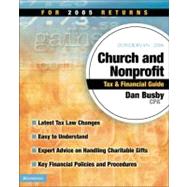
| Special Index for Church Treasurers | p. v |
| Introduction | p. viii |
| Recent Developments | p. 1 |
| Financial Accountability | p. 11 |
| Accountability to an independent board | p. 12 |
| Accountability to donors | p. 19 |
| Tax Exemption | p. 25 |
| Advantages and limitations of tax exemption | p. 25 |
| Tax exemption for churches | p. 27 |
| Starting a nonprofit organization | p. 28 |
| Unrelated business income | p. 32 |
| Private benefit and private inurement | p. 39 |
| Filing federal returns | p. 42 |
| Postal regulations | p. 50 |
| State taxes and fees | p. 50 |
| Political activity | p. 53 |
| Compensating Employees | p. 55 |
| Reasonable compensation | p. 55 |
| Housing and the housing allowance | p. 56 |
| Deferred compensation | p. 61 |
| Maximizing fringe benefits | p. 63 |
| Nondiscrimination rules | p. 84 |
| Paying employee expenses | p. 85 |
| Employer Reporting | p. 95 |
| The classification of workers | p. 95 |
| Reporting compensation | p. 99 |
| Payroll tax withholding | p. 100 |
| Depositing withheld payroll taxes | p. 103 |
| Filing the quarterly payroll tax forms | p. 104 |
| Filing the annual payroll tax forms | p. 107 |
| Refunds and abatements | p. 116 |
| Information Reporting | p. 117 |
| General filing requirements | p. 117 |
| Reporting on the receipt of funds | p. 119 |
| Reporting on the payment of funds | p. 119 |
| Summary of payment reporting requirements | p. 127 |
| Financial Records | p. 129 |
| The money comes in | p. 129 |
| The money goes out | p. 134 |
| Accounting records | p. 137 |
| Financial reports | p. 143 |
| Budgeting | p. 154 |
| Audit guidelines | p. 154 |
| Charitable Gifts | p. 161 |
| Charitable gift options | p. 162 |
| Percentage limitations | p. 166 |
| Gifts that may not qualify as contributions | p. 166 |
| Charitable gift timing | p. 169 |
| Acknowledging and reporting charitable gifts | p. 170 |
| Acknowledging and reporting gifts of autos, boats, and airplanes | p. 179 |
| Quid pro quo disclosure requirements | p. 182 |
| Special charitable contribution issues | p. 187 |
| Citations | p. 207 |
| Index | p. 210 |
| 10 Biggest Tax and Financial Mistakes Made by Churches and Nonprofits | p. 213 |
| 10 Tax and Finance Questions Most Frequently Asked by Churches and Nonprofits | p. 214 |
| Table of Contents provided by Ingram. All Rights Reserved. |
The New copy of this book will include any supplemental materials advertised. Please check the title of the book to determine if it should include any access cards, study guides, lab manuals, CDs, etc.
The Used, Rental and eBook copies of this book are not guaranteed to include any supplemental materials. Typically, only the book itself is included. This is true even if the title states it includes any access cards, study guides, lab manuals, CDs, etc.
Excerpted from Zondervan Church and Nonprofit Tax and Financial Guide: For 2005 Returns by Daniel D. Busby
All rights reserved by the original copyright owners. Excerpts are provided for display purposes only and may not be reproduced, reprinted or distributed without the written permission of the publisher.